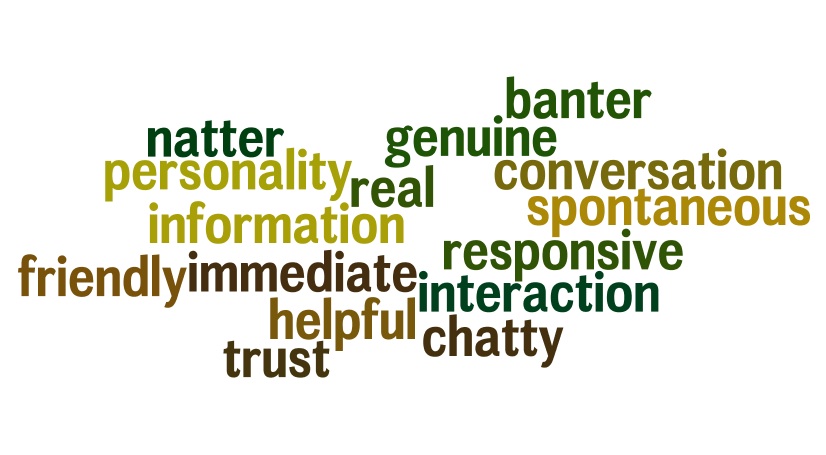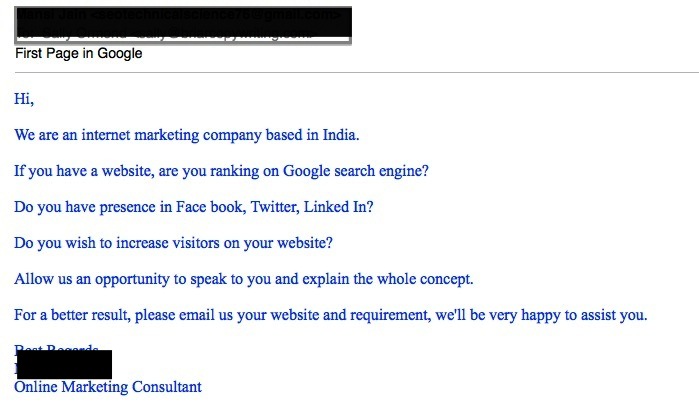March 7th, 2014 — social media, social media marketing, social networking

Social media is a must for any business these days.
It’s a fantastic way to have immediate contact with your customers, interact with them and develop long lasting relationships.
That word, ‘relationships’, is very important, which is why I’m dumbfounded at the number of companies that farm out their social media activities.
As the image above shows, social media is all about interacting, chatting, having a bit of banter and generally conversing with your customers.
Your customers follow you on Twitter and Facebook because they want that immediacy of contact, they want to feel part of your business and they want to be able to talk to you whenever they want.
Granted, social media can be time consuming (if you let it), but that’s no excuse to get someone else to do it for you.
Feeling cheated
If you followed your favourite celebrity on Facebook or Twitter, how would you feel if you posted something and they responded to you?
On top of the world probably.
But how would you feel if you later discovered that the celebrity in question hired someone to write the tweets and updates for him or her? What you thought was a personal message from them was in fact nothing other than a response from a faceless person.
Well that’s how your customers will feel if they knew their messages weren’t being read by you or responded to by you.
Any trust they had in you would be eroded beyond repair.
Immediacy of contact
The whole point of social media is to be able to instantly reach your customers with news, information and updates.
If you hire someone to do that for you they have to phone or email you to find out what’s happening, wait for you to reply, then put out tweets and updates. What’s the point? In the time that took, you could have sent out the update yourself.
A bit of banter
For me, one of the greatest aspects of social media is the way you can show the personality behind your business.
People can get to know you, like you and trust you.
But if you’re not the one sending out the tweets and updates, how can your customers really get to know you?
It’s not your personality that’s coming across so there will be a disconnect between what they read and what they see when they meet you or do business with you.
Stop outsourcing your social media and talk to your customers. It doesn’t have to be time consuming and, assuming you have a smartphone it can be done anywhere.
Rant over.
Sally Ormond – copywriter, tweeter, MD Briar Copywriting Ltd
March 5th, 2014 — Google algorithms, Link Building, Matt Cutts, seo
The search engine optimisation industry has been hotly debating the relevance of back links in search engine algorithms.
Some SEOs believe that social signals have replaced links, making link building techniques (such as article marketing) irrelevant to today’s internet marketers.
Certainly, social signals are important, but links will always play a dominant role as a ranking factor – at least for now.
If you don’t believe me, here’s Matt Cutts:
Links are here to stay, but there’s little doubt that ranking factors are getting more complicated.
Google wants to provide the best possible search experience for its users, therefore (whether you like it or not) it will continue to tweak its algorithms.
So, if you want to keep ahead of the ranking game, don’t try to out smart Google, just stick to giving your readers what they want:
- Great content, products and services that your customers want
- A responsive website
- Interaction with the social channels relevant to your market and customers
Above all, abide by Google’s rules, forget keyword stuffing and writing content that’s aimed at the search engines, and create a web presence that’s designed to give your customers what they want.
Sally Ormond – Copywriter, Briar Copywriting Ltd
March 3rd, 2014 — social media, social media marketing, social networking
Social media is a revelation.
It is immediate, interactive and great fun. Now you can chat with your customers any time, any where and you can ‘get’ to those hard to reach decision makers who have always hidden behind an impenetrable wall of secretaries.
But with all the different platforms about, it can be difficult to make sure you’re getting the most from them.
Well, as usual I’ve been scouring the Internet to find some tools that will help you use social media more effectively.
My search led me to Social Media Examiner who have asked a gaggle of social media professionals for their take on their favourite social media tool.
They came up with a list of 29:
- RivallQ
- Pocket
- ShareRoot
- PowToon
- EveryoneSocial
- vCita
- OptinMonster
- smqueue
- Nimble
- BuzzSumo
- Harvest
- Calendly
- Friends+Me
- BuzzFork
- Newsle
- Piktochart
- 22Social
- Jelly
- NeedTagger
- Pushover and IFTTT
- Swayy
- Circloscope
- Songza
- Talkwalker
- Hang w/
- Meddle
- tchat.io
- Canva
- LeadPages
You can read more about them and what they can do for you here.
February 28th, 2014 — email copywriting, email marketing
You may think it rather odd that I’m writing about the failure rate of spam emails.
Well, the reason for my madness is that you can learn a lot from the spammers about how not to do email marketing.
When you send out emails to potential clients, do you think carefully about your subject lines, presentation and content before hitting send?
I’m not going to go into detail about how to make your email marketing work, if you follow that link you’ll find a post that tells you all about that, instead I want to take an example of a spam email and highlight the areas the sender has got wrong.
You see if you get the same areas wrong your emails could end up looking like spam and that’s something you want to avoid at all costs.
Are you ready?
Here’s the email – I have blanked out names to save blushes.

Before I talk about the areas you can see, I would like to point out that although this apparently came from a company, the email was a gmail.com address. If you are a legitimate company you should have a company specific email address, i.e. Joe@velocitylighting.com not velocitylighting@gmail.com.
Subject line
The first thing I want to look at is the subject line. This sender has used “First Page in Google”.
First off no one can guarantee a first page ranking in Google, so instantly, I can smell spam.
It’s not a descriptive subject line either; it doesn’t entice me to click on it to learn more. If you want people to open your emails your subject line must grab their attention.
Greetings
What about the salutation?
“Hi”.
That shows this is a blanket email they’ve sent to all and sundry. When sending out your email campaign make sure you address the recipient my name. This should be easy because you’ll be using your own list rather than a random one you’ve bought in (won’t you?).
It may seem a small thing, but addressing someone by his or her name will go a long way to build trust.
Email content
Then we get into the body of the email. Again, you can instantly see this email is a blanket mailing because it’s asking if I have a website, is it ranking, do I use Facebook, Twitter or LinkedIn? Again, if they knew me they’d already know the answers to those questions.
Yet another fail.
They then go on to ask for the opportunity to speak to me and explain the whole concept. What concept?
- Having a website?
- Ranking in Google?
- Using Facebook, Twitter and LinkedIn?
- Increasing visitors to my website?
There are so many issues it’s impossible to know exactly what they’re offering because there is no focus.
The most powerful emails (landing pages, web pages etc.) focus on one idea. Any more than that and you begin to dilute your message.
It’s also important to watch your English, spelling and grammar. Look at the last line:
“For a better result, please email us your website and requirements, we’ll be very happy to assist you.”
How can I email them my website? I can email the URL, but not the physical website. Plus, this again shows they have done no research whatsoever on my business, because if they had, they’d know my web address.
Signing off
Last, but not least, look at the signature at the bottom.
I know the sender is an Online Marketing Consultant, but I have no idea from which company – no branding – yet another epic fail.
Hopefully, looking at this obvious spam email has helped you understand more about how email communications should be written and the pitfalls you must avoid if you want to be taken seriously.
Author: Sally Ormond
February 26th, 2014 — blog, blogging, blogging for business

This is a question I’m asked a lot.
Should it be short and sweet, or should it be a lengthy, complicated in depth look at a particular topic?
On top of that, should it be conversational and friendly, or should it be strictly professional and formal?
There are no right or wrong answers.
Everyone loves different things.
Personally, I prefer short, chatty and informative posts that get across a point or concept quickly and easily.
A long blog post, no matter how well written, will never hold my attention because I always have a pile of stuff to get through so I don’t have the time to sit and wade through complex arguments and ideas.
Yet there are people out there who love long posts.
The best piece of advice I can give is to take a look at the audience you are writing for. What do they like? If your company deals with high brow financial, medical or complex issues, your writing will probably be more formal than if you were involved in design or marketing. But that doesn’t mean to say all your posts have to be long and ‘dry’ (in the nicest possible sense of the word). Throw in a few short, pithy posts now and then to liven things up and add interest.
That’s really all I have to say.
Over to you – what type of blog posts do you prefer? Leave a comment below and tell me what industry you write for and the main type of post you publish.
I’d be really interested in your input on this one.
Author: Sally Ormond, copywriter at Briar Copywriting Ltd.







